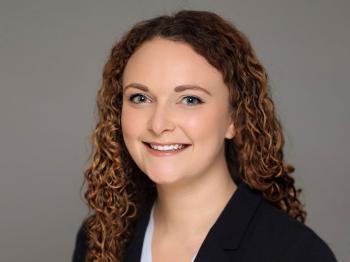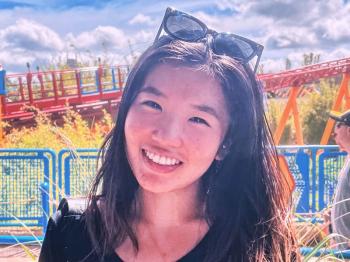Summer interns investigated methods to improve immunotherapy, tailor survivorship programs, and target cancer cells using antibiotics.
By Raleigh McElvery, Scientific Communications Editor
August 4, 2022
Flashy findings make headlines, but it’s the lessons learned at the lab bench that often shape careers and introduce budding researchers to the scientific process. The NCI Center for Cancer Research's Neuro-Oncology Branch (NOB) fosters the next generation of innovators by going beyond reading papers and protocols to offer immersive, hands-on research experiences to undergraduate and graduate students through programs such as the Translational Research Immersion Program (NOB-TRIP).
For 10 weeks each summer, NOB-TRIP interns team up with accomplished clinicians and laboratory professionals to conduct patient-centered research. They also attend lectures, career planning workshops, and weekly seminars with the branch leadership. The program culminates in the annual NIH-wide Summer Poster Day, where the interns present scientific posters detailing their projects and findings.
“Observing the transformation of these trainees as they successfully work on projects and then skillfully present their work in a formal meeting is highly rewarding,” says the NOB’s Chief Mark Gilbert, M.D. “Programs such as NOB-TRIP are invaluable because they provide a positive experience while enabling trainees to understand what is required to be successful in this career path.”
This year, three NOB-TRIP interns represented the branch at the virtual Summer Poster Day on August 3: Caitlin Huguely, Kimberly Reinhart, and LaYow Yu. Their projects ranged from investigating ways to improve immunotherapy to researching tailored survivorship programs and probing the ways antibiotics affect cancer cells.
Caitlin Huguely
A neuroscience major and rising senior at the University of North Carolina at Chapel Hill, Huguely interned in the Translational Immunology Program under the tutelage of Dr. Gilbert and Staff Scientist Masashi Watanabe, Ph.D. Her mission was to analyze patient samples to understand why glioblastoma tumors are so resistant to immunotherapy.
Because these tumors are masters at suppressing the brain’s own immune cells, the researchers wondered whether they could use immune checkpoint inhibitors (ICIs) to activate immune cells outside the brain (also called the peripheral immune system), and then guide those cells into the brain to fight the tumor. Huguely’s job was to determine if this was a feasible hypothesis by analyzing blood samples from two patients taking ICIs. She searched for specific markers called cytokine proteins and determined that the peripheral immune system was indeed responding to the ICI treatment. The researchers hope that tests like these will ultimately help determine which glioblastoma patients will benefit most from enrolling in ICI trials.
Huguely says her favorite part about working at the NOB is that everyone is extremely supportive. “I have been able to have great conversations with so many different people who have taken the time to explain their work and give me very helpful advice on career development,” she explains. “My work at the branch has made me realize the excitement that can come from intersecting multiple fields, and I have been grateful to be able to learn fascinating aspects of neuroimmunology and cancer neuroscience. I am looking forward to continuing this exploration as I take a neuroimmunology course this fall.”
Kimberly Reinhart
Before arriving at the NOB, Reinhart received her bachelor’s and master’s in occupational therapy from D’Youville University. She’s currently enrolled in the master of public health degree program at Yale University, with a focus on chronic disease epidemiology. As a member of the Patient Outcomes Program this summer, she performed analyses on data from the NOB’s ongoing Natural History Study under the supervision of Deputy Chief Terri Armstrong, Ph.D., and Mathematical Statistician Elizabeth Vera.
Central nervous system tumors can occur in people of all ages, but symptom burden and general health status vary between young and older adults. Reinhart investigated whether some age groups would benefit from tailored survivorship programs that meet their unique sociodemographic characteristics and clinical needs. She found that young adults (age 18 to 39) were more likely to be single, have lower income, be employed, and have less education than those above age 40. She also deduced that young adults may be more amenable to lifestyle approaches and require targeted supportive care programs.
“I have always been passionate about completing cancer survivorship research,” Reinhart says. “Although my experience this summer did not change my career trajectory, it reinforced my desire to make a difference through completing survivorship research. My favorite part about working at the NOB this summer has been having the chance to learn from amazing mentors and attend various educational meetings and seminars.”
LaYow Yu
A rising senior at Washington University in St. Louis majoring in biochemistry, Yu worked in the Cancer Stem Cell Biology Program with Senior Investigator Zhengping Zhuang, M.D., Ph.D., and Jing Cui, Ph.D., a postdoctoral fellow at the National Institute of Allergy and Infectious Disease. Yu had previously interned in Dr. Zhuang’s lab, and returned this summer to study a macrolide antibiotic called Carrimycin with the potential to target cancer cells.
Previous research showed that the active component of Carrimycin, called ISP I, exhibited anticancer activity, but no one was sure exactly how it exerted its effects. This summer, Yu found that ISP I can bind to and accelerate the degradation of one protein inside cancer cells called selenoprotein H (SELH). This kicks off a chain of molecular events that causes an accumulation of toxic chemicals, DNA damage, impaired cell function, and ultimately cell death.
“My favorite part of working at the NOB was how involved everyone was in my research and how they took a genuine interest in my training process as a young scientist,” Yu says. “Everyone — from the branch directors to my fellow lab members — consistently made efforts to give me feedback and help me learn, and it really made me feel like I was visible and that I mattered as a trainee. I gained a lot of confidence as a researcher, and I think the environment at the NOB really helped me to do that.”
Dr. Armstrong, who has mentored NOB-TRIP interns for many summers, explains that these students often bring new perspectives and innovative insights to the branch’s research.
“Seeing the work and data through ‘fresh eyes’ advances our research,” she says. “I love their enthusiasm for their work, exposing them to neuro-oncology patient care issues, and the new ideas that they bring to the program. I also enjoy staying in touch and watching them grow in their careers!”


